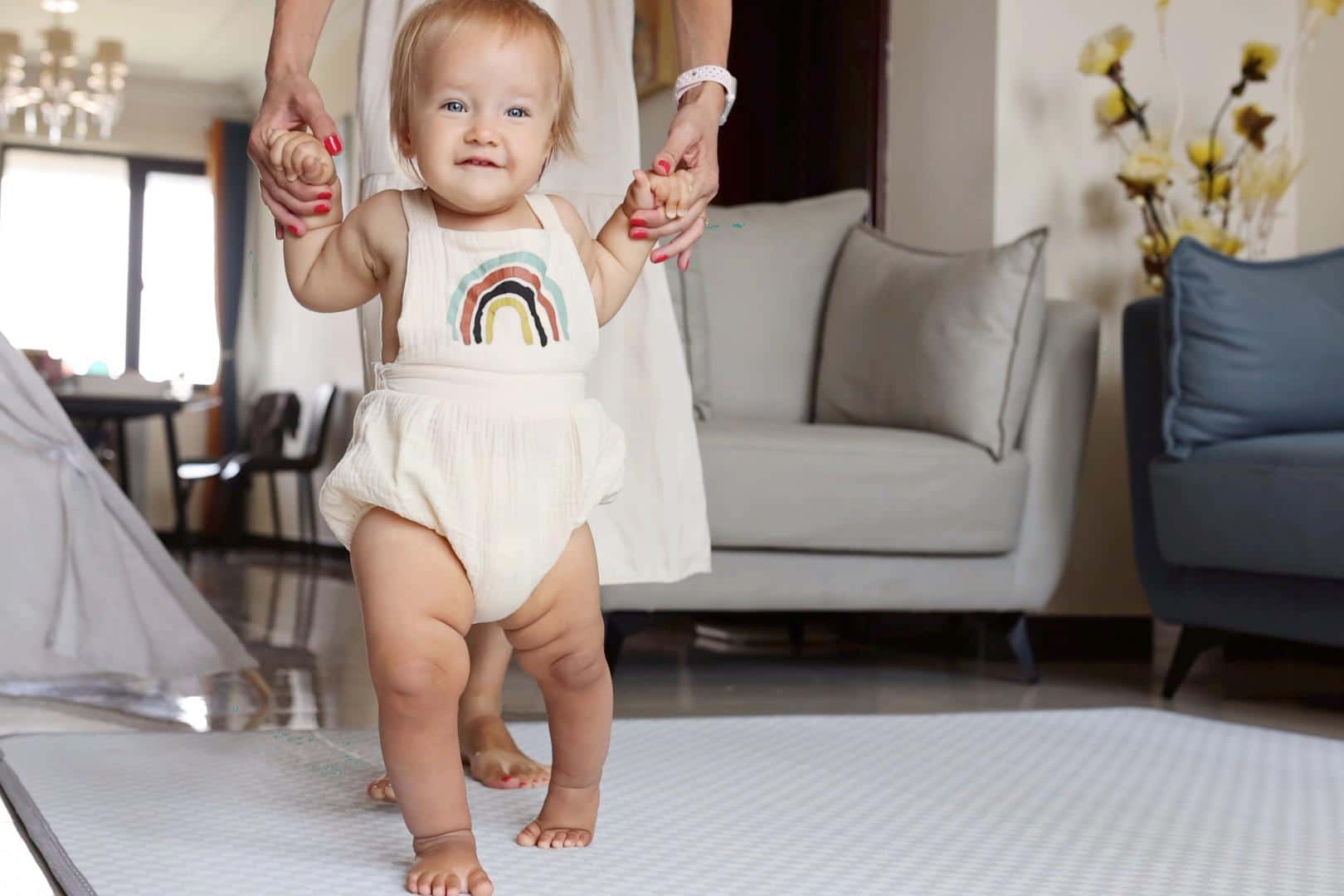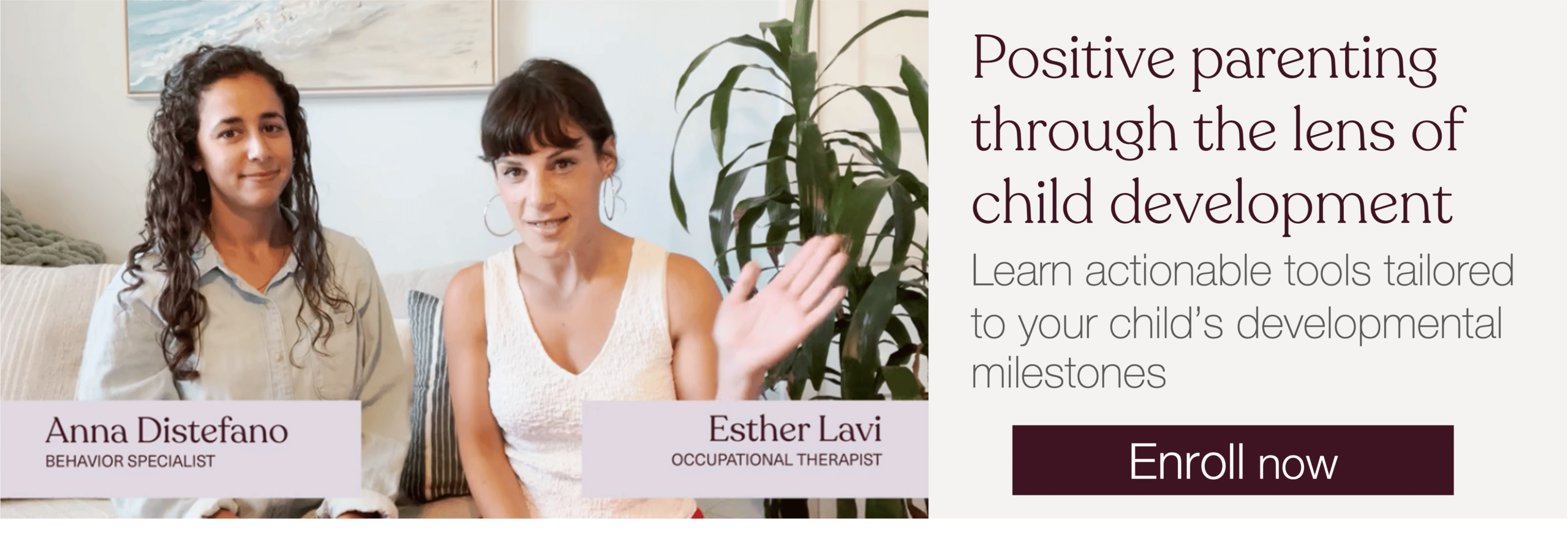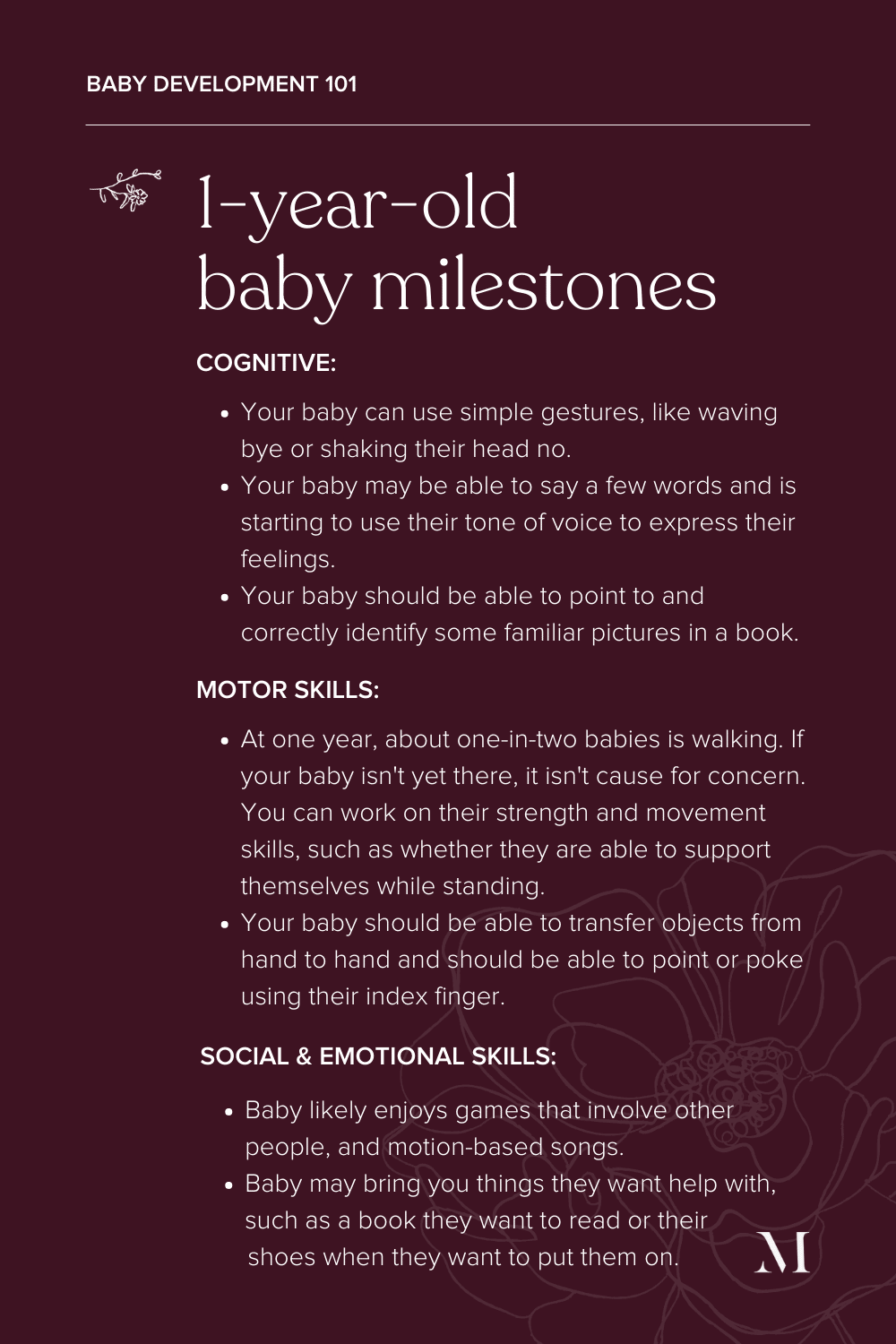12-month-old baby milestones

Your newly minted toddler is busy these days—but be sure to take some time to reflect on the milestones you've reached, too, right alongside your little one.
We independently select and share the products we love—and may receive a commission if you choose to buy.
Table of Contents
Happy birthday to your baby—and congratulations on the big milestone moment for you, too! As your baby transitions into becoming a toddler, you might be on your toes a bit more often. Along with all of the movement, they are constantly learning about the world around them and it shows with their developmental milestones. Right now, your baby may not be able to say many words, but they likely know what you’re saying. (This is called receptive language.) They are also very curious, which means you’ll want to double-check the baby proofing in your house.
Help fuel their bodies and minds with developmentally appropriate activities. By keeping track of what milestones your 12-month-old baby is working on achieving, you can support their development and consult with your pediatrician if you have any questions or concerns.

12-month milestones at a glance
First birthdays are a big deal, mama, not just for your little one. It marks your first anniversary as a mother, too, and that’s something worth celebrating. Your newly minted toddler is busy these days—working on walking, talking and noticing everything and everyone around them—but be sure to take some time for yourself to reflect on the milestones you’ve reached, right alongside your little one.
Related: Celebrating your first birthday as a mom: Why turning one is a big deal for mamas
An in-depth look at 12-month milestones
Read on to find out what you need to know about 12-month-old baby development this month to best support your little love’s growth.
12-month developmental milestones
Here’s what The American Academy of Pediatrics (AAP) and the Centers for Disease Control and Prevention (CDC) say about 12-month-old baby milestones.
(Editor’s note: The 12-month milestone guidelines were written to reflect the behaviors that 75% or more of children exhibit at a certain age. Note that milestones are not a perfect metric: It’s key to speak to your pediatrician if you have concerns about your unique child.)
Cognitive
- Your baby can use simple gestures, like waving hello or bye. Your tot may also understand the word no, pausing or stopping something when you say it, or shaking their own head “no” to show when they don’t want something.
- By 12 months, your baby may be able to say a few words and is starting to use their tone of voice to express their feelings.
- At 12 months, your baby is very curious. They might enjoy repeatedly putting items into a container, dumping things out and shaking things to see what happens next.
Motor skills
- Your baby may or may not be walking on their own. If your baby isn’t yet there, it isn’t cause for concern. Look instead at the bigger picture of their strength and movement skills, such as whether they are able to support themselves while standing and if they can step forward while holding onto furniture.
- After observing the use of objects for a while now, your baby has the skills to start using them correctly—like using a fork for food, putting a hat on their head, drinking from a sippy cup and so on.
- Your little one should be able to pick up small pieces of food using their index finger and thumb, in what’s known as the pincer grasp.
Related: The best learning towers for independent toddlers
Social and emotional
- Your baby may seem hot and cold when it comes to other people: They either love them (like you!) or are shy and uncomfortable (like around strangers). This can make navigating social situations a bit challenging, but it’s right on track for your baby’s development.
- Your 12-month-old baby likely enjoys games that involve other people, such as peekaboo, pat-a-cake and motion-based songs like “The Wheels on the Bus”.
- Your baby might gesture to or bring you things they want help with, such as a book they want to read or their shoes when they want to put them on.
Related: 12 sensory toys to stimulate your 1-year-old, according to a child development expert

Baby’s sleep at 12 months
We hope that sleep has been getting better for you and your little one now that they’ve reached this milestone birthday. But it if still proves tricky, or feels like every night is a wildcard, it’s time to get back to the basics. Keeping a consistent nap and bedtime routine, gently promoting self-soothing measures at night and getting plenty of outdoor time during the day can all help reset.
Once your child turns 12 months old, the American Academy of Sleep Medicine states that your baby’s sleep needs shift from 12 to 16 hours of sleep to 11 to 14 hours of sleep around the age of 12 months. Of course, this doesn’t happen overnight—and may have already taken effect, or might be around the corner for you. Keep aiming for a solid 10 to 11 hours of consecutive nighttime sleep, and the rest can be filled in with two naps during the day.
What baby sleep looks like at 12 months:
- Your baby may be taking 2 naps per day
- Your baby may no longer be waking at night
- Your baby may be awake for 2.5 to 3.5 hours at a time
A big sleep progression is coming soon, too, shares Rachel Mitchell, a certified sleep consultant and founder of My Sweet Sleeper. “The 12-month mark is such an exciting milestone for both of you,” notes Mitchell. “A major progression can happen at this stage, which is related to specific leaps as well as generally increased independence and physical growth.”
But not all babies are negatively affected by this progression, Mitchell notes. If you’re starting to see your tot wake up at night or start to take short naps, try not to stress. Stay consistent and things should normalize after a week or so.
Read more: How much sleep does a 12-month-old baby need?
Feeding a 12-month-old
Are you planning for baby’s first cake? Now that your little one is officially a toddler, a sweet treat might be in order. But aim to keep added sugar in other settings at bay—AAP recommends holding off until age 2 if possible. Your hungry bub can also try drinking cow’s milk now instead of formula—and breast milk can still be offered, as long as breastfeeding is still workable for both of you. AAP now recommends extending breastfeeding at least until age 2, and we have tips on how to make extended breastfeeding happen if it’s a goal you’re striving for.
The AAP and La Leche League (LLL) recommend the following feeding timeline and amounts for 12-month-olds:
- Solids: Offered three times per day or at family mealtimes
- Breast milk: Up to eight ounces every four to five hours
- Formula: Seven to eight ounces every five to six hours
Your 12-month-old should be no stranger to solids. Here are the recommended serving sizes for an 12-month-old baby:
- Infant cereal (single grain) mixed with breast milk or formula: five to eight tablespoons (optional)
- Fruits: two to four tablespoons
- Vegetables: two to four tablespoons
- Shredded meats, eggs, yogurt and soft-cooked plant-based proteins, such as lentils: two to three tablespoons
- Starches: ¼ to ½ cup simple carbs, such as pasta, mashed potatoes, bread
Read more: 12-month-old baby feeding schedule & expert advice
12-month-old health & growth
By their first birthday, many babies have more than doubled—or maybe even tripled their birth weight. The 1-year mark is a time of big change, of course, and you might see a growth spurt happening around now. But don’t worry, most growth spurts only last a few days—and they’re a harbinger of your baby’s healthy development.
How much does the average 12-month-old weigh?
According to the WHO:
- A 12-month-old baby boy in the 50th percentile weighs 21 pounds 3 ounces (9.6 kilograms)
- A 12-month-old baby girl in the 50th percentile weighs 19 pounds, 10 ounces (8.9 kilograms)
How long is the average 12-month-old?
According to the WHO:
- A 12-month-old baby boy in the 50th percentile is 29 ¾ inches long (75.7 cm)
- A 12-month-old baby girl in the 50th percentile is 29 inches long (74 cm)
Read more: 12-month-old baby health & growth guide
Activities for 12-month-olds
We’re betting your tot can find myriad ways to stay busy these days, but they may not be exactly what you were thinking. Here are a few fun and safe ways to channel all that energy into sensory and motor skills development.
Storybook hide-and-seek: At this stage, lift-the-flap books are doubly exciting, not just for the story but because of their interactive possibilities. Now that your little one is using their pincer grasp, it’s even easier (and more fun!) for them to lift up flaps or turn pages of a board book. Ask them if they can find the ball or where the bear is hiding, and then wait for the joy when they find it.
Sing-along: Playful songs that pair music with gestures like “Pat-a-Cake” and “Open, Shut Them” help your tot take an active role in music and movement. Set up a playlist for a morning sing-along and dance session.
Puzzle mania: Wooden puzzles can be equally satisfying for tiny hands these days, now that your little one is learning more about shapes, colors and hand-eye coordination. Help them fit the pieces back in, rotating them if necessary, and cheering them on when they fill all the missing spots.
Our favorite products for 12-month-olds
Supporting your 12-month-old baby’s development
Ready to make the most of those wake windows? These 12-month-old baby activities can support your cutie’s development.
- Help your 12-month-old baby learn to identify pictures by reading books with objects and animals that your baby can help point out while you name.
- Play with your 12-month-old baby by encouraging the thrill of discovery. A low, stable activity table or cube can help motivate your baby to explore.
- Encourage your 12-month-old baby’s sense of self by giving them two good choices, such as “do you want to drink from the red cup or green cup?”
It’s science: Your affection can shape your child’s happiness for life
As a parent, the little things can make a big difference—especially when it comes to an extra cuddle at the end of the day or a big display of enthusiasm when your baby is proud of themselves. Research shows that kids who experience affection during childhood reap the benefits throughout their lives. As your baby gets older (and enters toddlerhood!), you can show your affection not only through snuggles, but also through play and positive affirmations.
Related: Optimistic kids have parents who do these 6 things
A note from Motherly: 12-month milestones
Can we just say something? You’re amazing, mama. The first year of your baby’s life was surely filled with highs and lows—and you did it. We’re betting you’ve learned a lot about them and yourself along the way, too. As you enter your little one’s second year, keep their developmental milestones in mind. If you have questions or concerns, bring them up with your child’s doctor. Early intervention leads to the best outcomes.
A version of this story was originally published on Oct. 17, 2021. It has been updated.





































